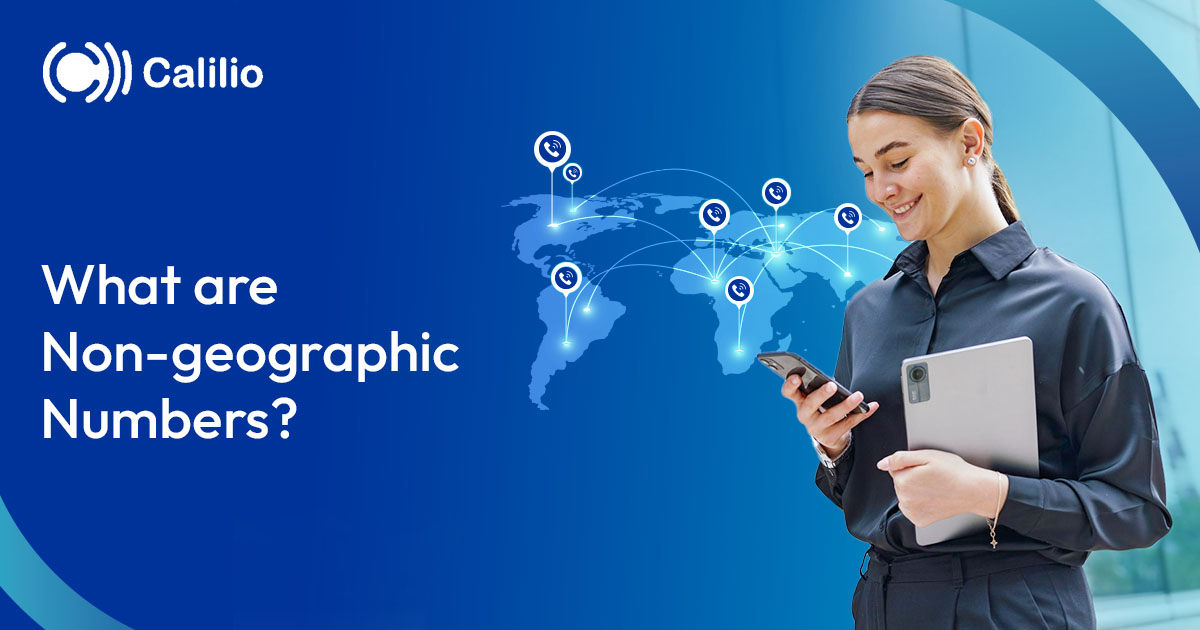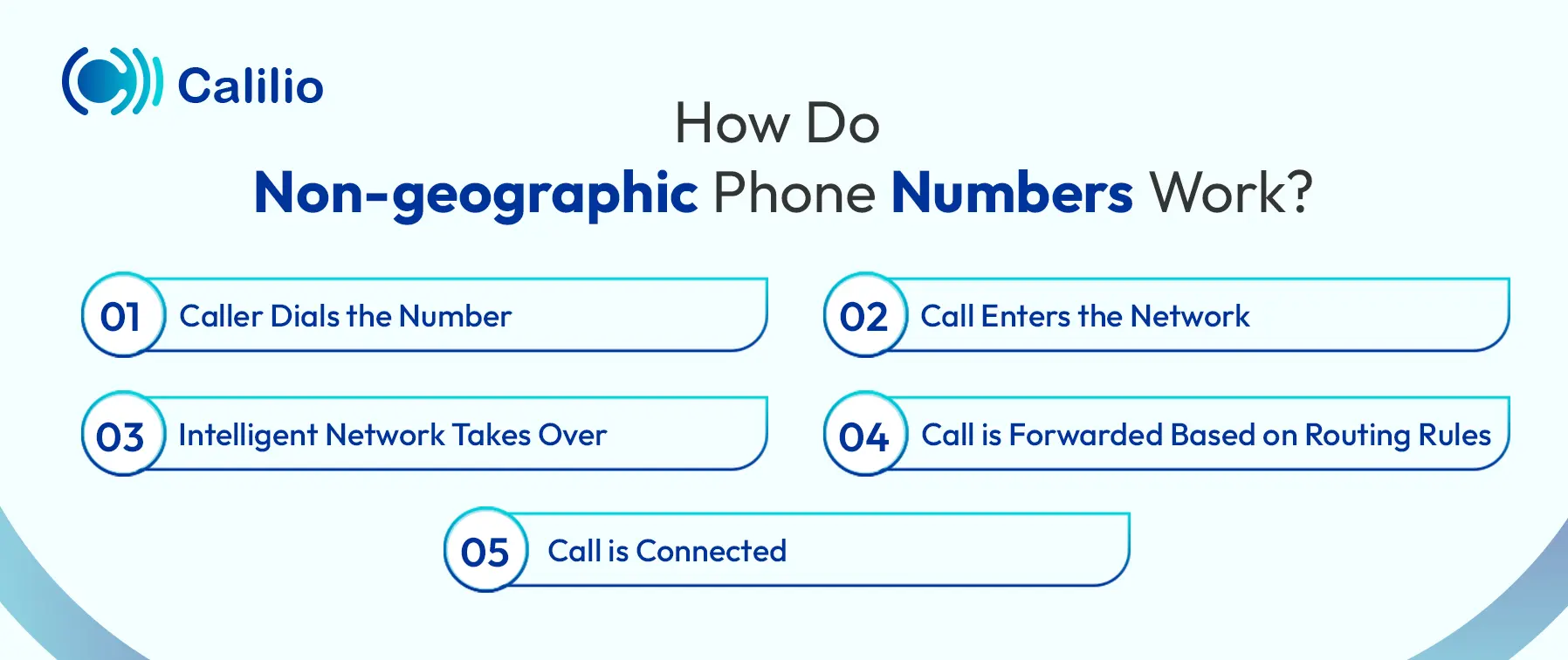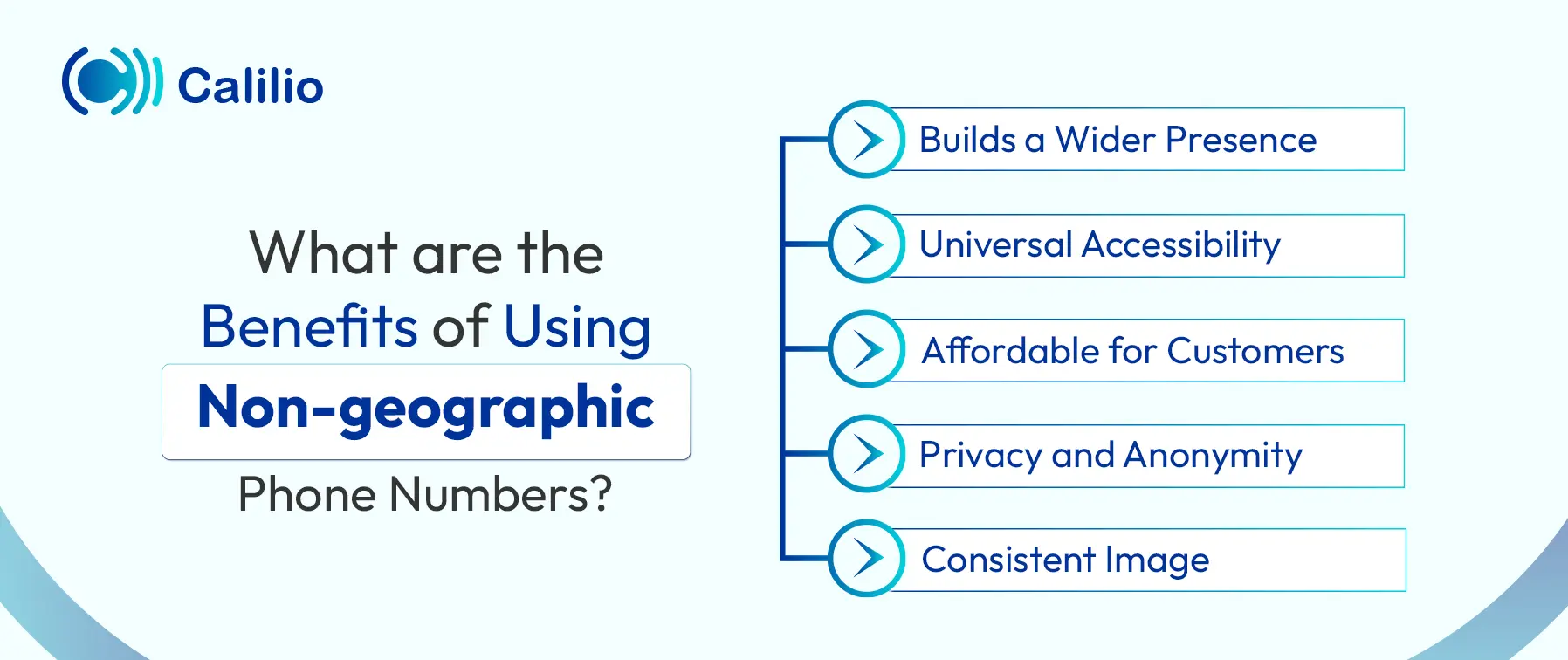What are Non-geographic Numbers? Types, Benefits & How They Work

Businesses today aren’t limited to a single location, and your phone number shouldn’t be either. While local phone numbers work well for nearby customers, they can discourage people outside the area from calling. They might see a local area code and assume your business only serves that region.
That’s where non-geographic numbers come in. Unlike local numbers, these numbers are not tied to any specific city or region. They make you look more professional, easier to reach, and consistent, no matter where your customers are.
In this blog, we’ll break down what non-geographic numbers are and how they work, including their types and benefits.
Key Highlights:
A non-geographic number (NGN) is a phone number that isn’t tied to a specific city, area code, or region.
The different types of non-geographic numbers include mobile numbers, toll-free numbers, emergency hotlines, and national numbers.
Calls to NGNs are routed through Intelligent Networks (IN) before they are forwarded to any destination (landline, mobile, or VoIP).
Non-geographic numbers enable businesses to have a nationwide presence, protect privacy, support scaling, and make it easier for customers to connect.
To get a non-geographic number, choose a trusted virtual phone number provider, select your preferred country and number type (such as mobile or toll-free), pick a number, and activate it online.
What is a Non-geographic Number?
A non-geographic phone number is a phone number that isn’t tied to a specific city, area code, or region. Instead, these numbers are easily accessible from anywhere in the country. Unlike traditional geographic numbers, these numbers don’t reveal the specific location of the phone number owner. So, they’re commonly used by businesses to establish a nationwide presence.
How Do Non-geographic Phone Numbers Work?
Non-geographic numbers typically work by forwarding calls through an Intelligent Network (IN), instead of relying on the geographic area codes. It uses special routing rules to forward your calls to any destination, such as a landline, mobile, or VoIP number.

- Caller Dials the Number: The caller dials a non-geographic phone number (e.g., an 0800 toll-free number).
- Call Enters the Network: The call is routed through the Public Switched Telephone Network (PSTN) or a Voice over Internet Protocol (VoIP) system.
- Intelligent Network Takes Over: Instead of going directly to a local phone line, the call reaches an Intelligent Network (IN) that recognizes the number as non-geographic.
- Call is Forwarded Based on Routing Rules: The Intelligent Network consults a database with routing instructions and forwards the call to its final destination, which could be a landline, mobile, or VoIP number anywhere.
- Call is Connected: The receptionist answers the call.
Types of Non-geographic Numbers
A non-geographic phone number can be primarily divided into 3 different categories: mobile numbers, toll-free numbers, and emergency hotline numbers.
Mobile Number
It is a unique series of digits assigned to a cell phone and is usable within the coverage area of the mobile network anywhere in the country. A mobile number format can vary depending on the nation, and many have specific mobile prefixes that represent a particular carrier provider.
Example (UK): +44 7700 900123
- +44 = Country code
- 7700 = Mobile prefix
- 900123 = Subscriber number
Note: Though a mobile number is a non-geographic number in most countries, some countries may include area codes in their mobile number. For example, the US phone number format includes the country code, area code, and then the unique subscriber number.
Toll-free Number
A toll-free number allows callers to reach businesses without paying a fee from anywhere within the country. These numbers are identified by unique prefixes, such as the 800 area code and its variations, 888, 877, and 866 in the North American Numbering Plan, the 400 area code for China, and 1800 for India.
Emergency Hotline Number
As the name suggests, an emergency hotline allows users to seek emergency assistance by dialing the number from anywhere in the country. In the US, the most common emergency hotline number is 911. Other examples are 100 for the Police, 101 for the Fire Department, and 102 for the Ambulance.
Unlike mobile and toll-free numbers, which can be accessed from other countries, an emergency hotline number is limited to a specified country.
What are the Benefits of Using Non-geographic Phone Numbers?
Non-geographic numbers help businesses establish a nationwide or global presence, remain accessible during growth or relocation, and reduce call costs for customers. They also enhance privacy while creating a consistent, professional brand image.

Builds a Wider Presence
Since non-geographic telephone numbers are not limited to a certain area, they create a broader presence for businesses. This helps them appear more accessible to customers beyond their local region and attract a wider audience.
Universal Accessibility
There’s also no need to change numbers for an enterprise during expansion and relocation, as they do not represent specific locations.
Affordable for Customers
Non-geographic numbers like toll-free numbers are cost-free to call. Removing cost barriers, these numbers encourage more inquiries, support sales, and boost overall customer engagement.
Privacy and Anonymity
A non-geographic phone number keeps your location private, giving customers a professional contact number without tying you to a specific place.
Consistent Image
Using the same number everywhere helps build trust and creates a unified brand experience for your customers. It builds trust by giving customers a consistent point of contact wherever they find you.
How to Buy Non-geographic Phone Numbers?
You can buy non-geographic phone numbers online through VoIP service providers.
Here’s how to get a non-geographic phone number from a reliable VoIP service provider, Calilio:
- Go to Settings> My Numbers > Purchase Number.
- Select your desired country and number.
- Complete your payment details and confirm your purchase.
- Upload the required documents for verification.
- Once activated, you can instantly start making and receiving calls using your new phone number from anywhere.
Note: In number type, mobile numbers and toll-free numbers are generally considered non-geographic, except in countries like the US and Canada, where mobile numbers include area codes.
Conclusion
Non-geographic numbers give businesses a flexible, cost-effective way to connect nationwide. They help create a consistent brand image, route calls intelligently across locations, and make it easier for customers to reach you, no matter where they are.
If you’re looking for a reliable non-geographic phone number provider, Calilio is a perfect choice. Calilio not only offers these numbers at an affordable cost, but they also come with additional telephony features. Its basic plan starts at just $15 per month. Get a non-geographic virtual phone number from Calilio today!
Your Phone System Just Got Cheaper
Virtual numbers from just $2/month
Call rates starting as low as $0.016/min
The most cost-effective VoIP phone system for businesses
Powered by advanced AI telephony features
Compare low-cost business phone systems
Frequently Asked Questions
What is the difference between geographic and non-geographic numbers?
The key differences in geographic and non-geographic numbers lie in the inclusion of the area codes. Geographic numbers are linked to a specific area code, meaning they show the location of the caller. Non-geographic telephone numbers, on the other hand, are not tied to any location.
What is a non-geographic code?
How much is an NGN call charged?

Still have questions?
Can’t find the answer you’re looking for? Please chat with our friendly team.
Stay in the loop
Get the latest call insights, trends, and updates delivered straight to your inbox.
By subscribing, you agree to receive updates from Calilio.
You can unsubscribe anytime.
Phone numbers
Get International Phone Numbers
Singapore
|Australia
|New Zealand